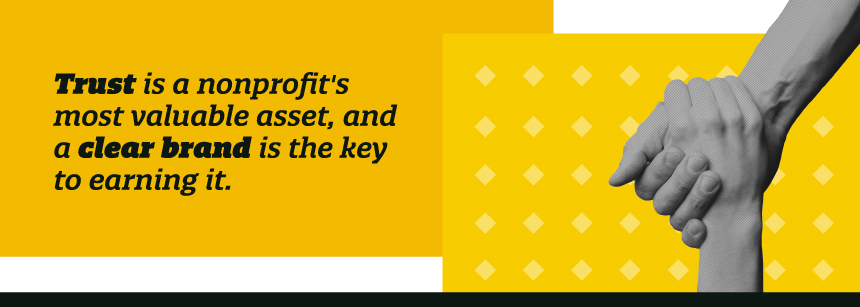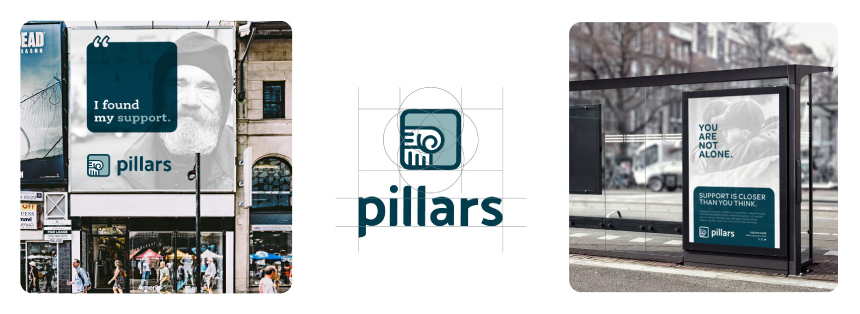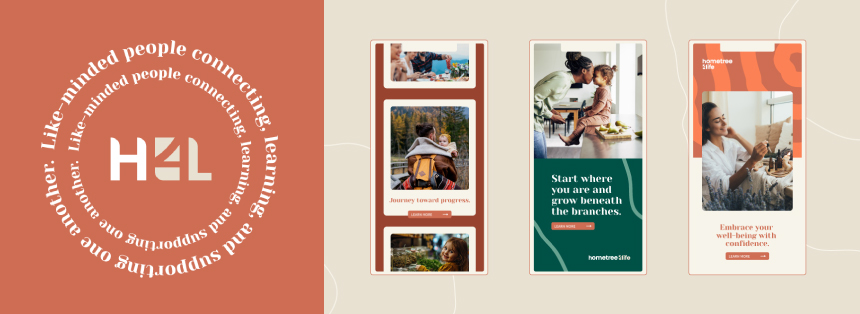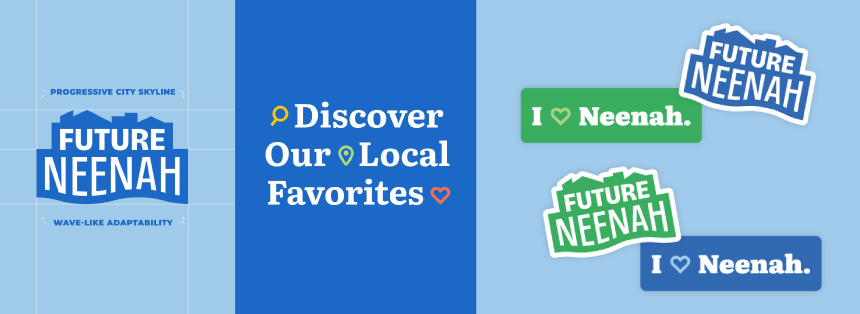More Than a Mission:
Why Nonprofits Can’t Afford to Ignore Brand Identity

When you think of nonprofit work, a few things might come to mind: Mission. Purpose. People who care deeply about changing the world. But what about branding?
For a lot of nonprofit leaders, “branding” might sound like something best left to big corporations or tech startups, not food pantries, arts organizations, or social justice movements. And that makes sense. After all, you’re here to do good, not to sell sneakers.
But in today’s world, branding isn’t just about making you look good in order to sell something. It’s about telling your authentic story and guiding people towards an emotional connection with your organization that sticks. It turns passive observers into passionate supporters and builds the trust you need to raise funds, rally volunteers, and grow your impact.
As Pip Emery of Amnesty International put it, “If you don’t know where you’re going and why you’re relevant, you don’t have a brand.” And if people don’t understand your relevance, they’re a lot less likely to donate, partner, or get involved.
Whether you’re just getting started or looking to refresh an outdated identity, this blog will walk you through why branding matters, what brand challenges nonprofits often face, and how a strong brand identity can help your organization grow and thrive.
Why Branding is Essential for Nonprofits
Let’s bust a myth right out of the gate: branding isn’t just for the big guys with million-dollar marketing budgets and glossy ad campaigns. It’s just as essential—arguably more so—for nonprofits trying to make a meaningful impact in their communities.
Nonprofits are in the business of trust. Whether you're asking someone to donate their hard-earned money, volunteer their time, or show up for your cause, people need to believe in you. That belief starts with how clearly and consistently you present who you are, what you do, and why it matters. That’s branding.
A well-crafted brand identity helps people emotionally connect with your mission. It gives your organization a recognizable face and voice, making it easier for people to remember you, share your story, and feel part of your work. Just like people rally around brands they love, whether it’s a favorite coffee shop or a sports team, they’ll rally behind a nonprofit that makes them feel emotionally connected to a cause they feel strongly about.
And the numbers back it up. Research capturing insights and experiences from around 500 senior decision-makers in the nonprofit sector paint a picture showcasing why branding is so important for nonprofits.
Some key findings:
- Nonprofits that invested in professional design in the last two years were 50% more likely to report an increase in fundraising revenue.
- More than two thirds of charities (68%) say a strong visual brand increases volunteer interest.
- Of the 26% of nonprofits that rebranded in 2022 and 2023, nearly half (47%) saw an increase in revenue.
In short, investing in your brand isn’t just a “nice to have.” It’s a smart, strategic move that directly impacts your ability to grow and do good.

The Power of a Strong Brand Identity
Besides looking polished and professional, a strong brand identity opens doors, builds trust, and creates the kind of alignment that helps organizations thrive, not just survive. Here’s how:

It Builds Trust and Credibility
Trust is the foundation of any nonprofit’s success. Donors, volunteers, community partners—they all want to know that you are who you say you are, and that you’ll do what you say you’ll do.
A clear and consistent brand identity helps reinforce that sense of reliability. When people see the same values, visuals, and voice across every interaction, they begin to feel a stronger sense of confidence in your organization. And that confidence translates into action, i.e. more donations, deeper partnerships, and long-term support.
It Fosters Internal Cohesion
A well-developed brand doesn’t just shape how the outside world sees you. It shapes how your team sees themselves as part of the organization.
When your staff, volunteers, and board members all understand and embrace a shared identity, it creates unity and focus. People know what they’re working toward, what the organization stands for, and how their efforts contribute to the bigger picture. That kind of alignment streamlines decision-making and helps your internal culture feel more connected and intentional.
When everyone is pulling in the same direction, things just run smoother.
It Supports Strategic Growth
A strong brand identity is also a strategic asset. It’s not just about being recognizable, it’s about being ready.
Organizations with a clear brand can respond more quickly and confidently to new opportunities, whether that’s launching a campaign, applying for a grant, or partnering with a like-minded group. And because a well-articulated brand clarifies your mission, vision, and values, it acts as a filter for making smart, mission-aligned choices.
The stronger and more cohesive your brand, the more efficiently you can deploy your resources, attract new supporters, and scale your impact.
Common Branding Challenges Nonprofits Face
If branding is so valuable, why do so many nonprofits struggle with it?
For starters, many nonprofit teams are stretched thin—juggling programs, fundraising, events, board meetings, and endless emails. Branding can easily fall into the “we’ll get to it eventually” category. But even when organizations do carve out time for branding, they often run into some common roadblocks.

1. Seeing Branding as Superficial
There’s a lingering perception in the nonprofit world that branding is somehow shallow. As if caring about your visual identity means you’re caring less about your mission. Some organizations worry that focusing on brand elevates style over substance or feels too commercial.
But this is a fundamental misunderstanding of what branding actually is. A strong brand doesn’t dilute your mission—it reinforces it. It’s how you communicate your values, build trust, and help people understand the importance of your work.
2. Struggling to Define Identity
Many nonprofits are so focused on service delivery and fundraising that they lose sight of who they are at their core. What do you stand for? What makes you different from similar organizations? How do you want people to feel when they interact with you?
Without clear answers, the brand can feel generic or inconsistent, and that makes it harder for people to connect with you.
3. Focusing Only on Fundraising
A lot of nonprofits treat branding like a fundraising tool and nothing else. While branding does help bring in donations), it’s also about long-term strategy, internal cohesion, and shaping the organization’s role in the world. When branding is only used to create fundraising appeals, it’s like only ever using a Swiss Army knife for the bottle opener.
4. Lack of Resources or Bandwidth
Let’s be real—not every nonprofit has a dedicated communications team or a budget for design. Because of this, branding is often handled reactively, when there’s a big event coming up or a grant that requires a polished pitch. Without a solid strategy in place, the brand becomes scattered or outdated.
This is where having an established brand strategy and identity really pays off. When your brand is clearly defined, you don’t have to reinvent the wheel every time a new opportunity or challenge comes up. Instead, you can work more efficiently, minimize decision fatigue, and show up with confidence.
5. Not Thinking Like a “Brand”
Nonprofits often assume that their mission is self-evident, and to the people who work there every day, it probably is. But the outside world needs more than good intentions to get on board. People need to recognize your organization and fully understand what you do in order to trust you. That’s where branding comes in.
Your mission is powerful but it can’t speak for itself without a platform. Your brand is that platform.
Elements of an Effective Nonprofit Brand
A strong nonprofit brand is more than a nice logo and a color palette (though, yes, those matter too). It’s the sum of all the parts that help people understand who you are, what you stand for, and why they should care.
Here are the essential ingredients that make a nonprofit brand not just good-looking, but genuinely effective:
1. A Clear Brand Strategy
Branding isn’t just a design exercise, it’s a strategic one. Many nonprofits lean on their brand mostly for fundraising or volunteer recruitment, but that’s only scratching the surface. A solid brand strategy connects your visual identity to your mission, values, and long-term goals. It gives your team a framework for making decisions and a roadmap for how to show up in the world.
When you have that strategic foundation in place, you’re not just reacting to opportunities, you’re leading with intention.
2. A Cohesive Brand Experience
One of the fastest ways to build trust is through a brand experience that feels clear, cohesive, and aligned from top to bottom.
When every part of your brand identity—visuals, messaging, actions, and values—feels like it belongs to the same story, it builds credibility. People can tell when an organization knows who it is, and that clarity invites confidence.
Cohesion also boosts internal alignment. When your staff, volunteers, and board all embrace a shared brand identity, it creates unity, streamlines decision-making, and reinforces a sense of shared purpose. That internal focus radiates outward, helping your nonprofit act more strategically, use resources more efficiently, and amplify its impact in the world.
The best part? As your reputation grows, so does your brand’s strength. Trust leads to visibility, visibility reinforces credibility, and credibility brings new opportunities and supporters.
3. Alignment Between Internal Identity and External Image
Your brand isn’t just what the public sees, it’s what your staff, board, and volunteers experience and embody every day. The most powerful brands are built from the inside out.
Internally, a strong brand helps everyone feel connected to the mission. It gives people a shared language and sense of purpose. Externally, it ensures that your public-facing image is a true reflection of your values and impact. When your internal and external identities are aligned, your organization feels cohesive and authentic at every level.
4. Core Values and Consistent Messaging
Your values aren’t just words on your “About Us” page. They should shape everything you say and do. That means consistently communicating those values through your messaging, tone, and storytelling. Whether it’s a grant proposal, an Instagram caption, or a thank-you letter to a donor, your voice should reflect who you are and what you stand for.
5. Brand Presence Across All Touchpoints
If your brand only shows up in your annual report or on your homepage, it’s not doing enough. Strong branding should touch every part of your organization.
That includes your emails, your promotional items, your social media, your signage, your event flyers, your onboarding materials… even the way your phone is answered or how you show up in community meetings. Every touchpoint is a chance to reinforce your identity and stay top-of-mind. The more consistent and recognizable you are, the easier it is for people to remember and support you.
6. Transparency and Authenticity
To a higher degree than consumer brands, nonprofits are built on trust, and that means authenticity is everything. People need to know you’re walking the walk. Be honest about your impact. Share your challenges as well as your successes. Avoid buzzwords and empty promises. In an age where audiences can spot spin a mile away, being real is your best asset and that must be reflected in your brand identity.
When your values are clear and your messaging is transparent, people are more likely to engage and stay engaged with your work. Authenticity builds loyalty. And loyalty builds momentum.

Quill Case Studies: Nonprofit Successes
From crafting brand strategies rooted in your values to designing visual identities that reflect your purpose, the team at Quill helps nonprofits show up in the world with clarity, confidence, and cohesion. Take a look at some of the nonprofit brands we’ve worked with and how rebranding or refreshing their brand led to continued success.
Pillars

In 2018, the Fox Valley Warming Shelter merged with Homeless Connections and the Housing Partnership of the Fox Cities. The three organizations decided it would be best to develop a new name and brand identity to better represent their role in the community. Our task was to create a brand that would deliver this vision.
Over the course of their existence, these three organizations had individually been a place of support. We knew that these roots would always be the foundation for their collective brand story, and with them now working together, we found that the name Pillars would be fitting. Pillars stand the test of time and are a solid structure that will hold up their community for generations to come. We then turned to creating a visual solution that would be approachable, supportive, and strong.
Today, Pillars is operating with a larger impact than they ever have and the community of volunteers and supporters are all working towards the common goal of supporting our community by working together.
Check out the full Pillars case study here.
Oshkosh Area Community Foundation

The Oshkosh Area Community Foundation approached Quill Creative Studio with a need to enhance their brand’s visual identity as they prepared for a new website development project. Recognizing the importance of creating a cohesive and impactful design system, the foundation wanted to solidify their visual elements to ensure consistency across digital and print materials.
To maintain their established brand equity, we began by auditing their existing identity, which included elements such as their logo, color palette, and other elements that had become synonymous with their brand. This audit helped us understand underlying inconsistencies and identify which components to retain and where refinements were necessary to align with their long-term goals.
Our creative process was guided by the foundation’s desire to present a polished, visionary, and nurturing brand image. A polished aesthetic would establish trustworthiness and professionalism, while a visionary design approach would project freshness and forward-thinking. The nurturing aspect of their identity was essential to creating an engaging and approachable presence. This collaborative phase allowed us to test ideas and gather feedback, ensuring that the final system was both effective and authentic to the brand equity they had already established.
Check out the full Oshkosh Area Community Foundation case study.
Hometree4Life

As a new nonprofit entering the wellness space, HomeTree4Life required a brand identity that would establish credibility, communicate its mission effectively, and create a sense of community. The challenge was to develop a visual and messaging framework that balanced professionalism with approachability while standing out in a growing industry. Additionally, the brand needed to resonate with both individuals seeking holistic health resources and potential donors supporting their mission.
Quill Creative Studio crafted a brand identity that reflects Hometree4Life’s commitment to integrative wellness, community support, and empowerment. The logo incorporates elements hidden in the negative space and structured typography, symbolizing growth and connection. A natural color palette with calming neutrals and vibrant accents was chosen to evoke trust, balance, and vitality. Key design elements, such as tree ring-inspired graphics, fine-line details, and rounded content boxes, create a cohesive and inviting brand experience across digital assets, promotional materials, and community engagement efforts.
HomeTree4Life now has a polished and professional brand identity that establishes a strong foundation for growth. With a clearly defined visual and messaging strategy, they are well-positioned to attract new supporters, expand their outreach, and create meaningful connections within the holistic wellness community.
Check out the full Hometree4Life case study.
Future Neenah

Future Neenah had built an impressive track record of strengthening the Neenah community through programming, events, and downtown development efforts. However, their existing visual identity lacked consistency and made it difficult for the public to recognize them as the driving force behind these efforts. They needed a refreshed brand system that aligned with their core mission, supported their diverse range of initiatives, and helped connect with a new generation of Neenah residents.
Through workshops and discovery sessions, we uncovered foundational elements of the brand and redefined their organizational pillars to clarify their mission: supporting downtown vibrancy, community engagement, and promotional initiatives for the City of Neenah. From there, we crafted a refreshed brand identity that was vibrant, inviting, and rooted in purpose.
The visual identity leverages a bold color palette, structured event logo system, and playful iconography that reflects the energy of the Neenah community. A flexible brand architecture was developed to bring cohesion across a wide range of events and programs while maintaining individual character. Photography guidelines focus on capturing real people and families enjoying Neenah’s vibrant spaces, helping to tell the story of a dynamic and welcoming community.
Check out the full Future Neenah case study.
Your Brand Is Your Voice. Make It Count.
A strong brand can unite your team, rally your supporters, attract funding, and help you grow with purpose. It’s not a distraction from your mission, it’s a powerful tool for advancing it. In a world full of noise, your brand is what helps people hear you clearly.
And you don’t have to do it alone.
At Quill, we specialize in helping mission-driven organizations build brands that are as strategic as they are inspiring. We believe that great branding can lead to real social impact, and we’d love to help you get there.
Let’s chat.

